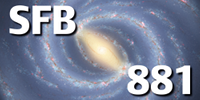Subproject A7: The Gravitational Potential and Phase Space Structure in the Solar Neighborhood
Andreas Just (ARI), Glenn van de Ven (MPIA)
Constraints on the local dark matter mass density. Determination of the origin of local phase space substructure (resonances or merging).
Inferring the local dark matter density is a challenge affected by, among other limitations, the still comparatively small stellar samples. A long-term goal of subproject A7 is to overcome these limitations in chemokinematical modeling for the extended Solar neighborhood. Excellent discrete data have become available over the past few years, but development of proper analysis and modeling methods has clearly been lagging behind. With our newly developed likelihood fitting approach, we have been able to show during the first funding period that the vertical and radial motions in the Milky Way disk are significantly coupled and robustly measure this so-called velocity ellipsoid tilt. This resulted in the problem that the commonly adopted modeling assumption of a zero tilt is invalid, but we succeeded in deriving and applying a new solution of the Jeans equations that allows for a non-zero tilt. These computationally-efficient Jeans models will make it possible to handle massive datasets such as from Gaia and to constrain the very large parameter range before applying more general but computationally-intensive modeling approaches like Schwarzschild's orbitsuperposition method.
Publications
den Brok, M., van de Ven, G., van den Bosch R. C. E., Watkins L. L.: "The central mass and mass-to-lightprofile of the Galactic globular cluster M15". MNRAS, 438, 487 (2014)
Watkins, L. L., van de Ven, G., den Brok, M., van den Bosch, R. C. E.: "Discrete dynamical modelling ofomega Centauri". MNRAS, 436, 2598 (2013)
Golubov, O., Just, A., Bienaymé, O., Bland-Hawthorn, J., Gibson, B. K., Grebel, E. K., et al. “Theasymmetric drift, the local standard of rest, and implications from RAVE data”, A&A 557, A92 (2013)
Kordopatis, G., Gilmore, G., ..., Just, A., et al.: “The radial velocity experiment (RAVE): Fourth data release”,ApJ 146, 134 (2013)
Ting, Y.-S., Rix, H.-W., Bovy, J., van de Ven, G.: “Constraining the Galactic potential via action-baseddistribution functions for mono-abundance stellar populations”. MNRAS, 434, 652 (2013)
Zhang, L., Rix, H.-W., van de Ven, G., Bovy, J., Liu, C., Zhao, G.: “The Gravitational Potential near the Sunfrom SEGUE K-dwarf Kinematics”. ApJ, 772, 108 (2013)
Liu, C., van de Ven, G.: “Chemo-orbital evidence from SDSS/SEGUE G-type dwarf stars for a mixed originof the Milky Way’s thick disc”. MNRAS 425, 2144 (2012)
Liu, C., Xue, X., Fang, M., van de Ven, G., Wu, Y., Smith, M. C., Carrell, K.: “A Resonant Feature Near thePerseus Arm Revealed by Red Clump Stars”. ApJ, 753, 24 (2012)
Lee, Y. S., Beers, T. C., An, D., Ivezic, Z, Just, A., et al. “Formation and Evolution of the Disk System of theMilky Way: [α/Fe] Ratios and Kinematics of the SEGUE G-dwarf Sample”, ApJ, 738, 187 (2011)


